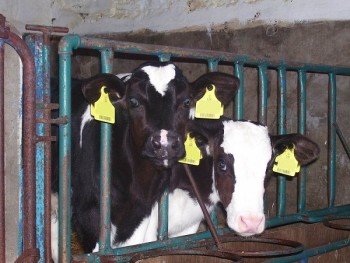Welfare of calves (SMR 11)
Date published: 1 January, 2015
The aim of these rules is to protect the welfare of calves by setting minimum standards for their care and husbandry. These rules apply in addition to the rules for the Welfare of farmed animals (SMR 13).
You must:
Inspection
1. inspect all housed calves at least twice a day, and those kept outside at least once a day
Accommodation and freedom of movement
2. make sure that individual stalls or pens satisfy the minimum width and length rules and that they have perforated walls which allow the calves to see each other and have physical contact with one another (except for those isolating sick animals*):
- width rule: must be at least equal to the height of the calf at the withers, when measured in the standing position
- length rule: at least equal to the body length of the calf (measured from the tip of the nose to the rear of the pin bone (tuber ischii), multiplied by 1.1
3. make sure that each of your calves can stand up, turn around, lie down, rest and groom itself without difficulty
4. make sure that each calf, when kept in a group, has its minimum allowance of unobstructed floor space*:
- at least 1.5 square metres for each calf with a live weight of less than 150kg
- at least two square metres for each calf with a live weight of 150kg or more but less than 200kg
- at least three square metres for each calf with a live weight of 200kg or more
5. provide flooring, for those calves kept in buildings, that is:
- smooth but not slippery
- designed so there is no injury or suffering to the calves standing or lying on it
- suitable for the size and weight of the calves
- rigid, even and stable
Environment
6. for calves kept in artificially lit buildings, provide artificial lighting for a period that is at least equal to the period of natural light normally available between 9am and 5pm
7. clean and disinfect housing and equipment used for your calves. Remove dung, urine and leftover food as often as necessary to reduce smells and avoid attracting flies or rodents
8. keep all housed calves on, or at all times give them access to, a lying area that is clean, comfortable, well drained and has dry bedding
9. give all calves appropriate bedding
Feed, water and other substances
10. feed all weaned calves at least twice a day
11. make sure when feeding group-housed calves that each calf either:
- has access to feed at the same time as the others in the feeding group
- has continuous access to feed
- is fed by an automatic feeding system
12. give all your calves fresh drinking water at all times in hot weather conditions or when they are ill
13. make sure that each calf receives bovine colostrum as soon as possible after it is born and within the first six hours of life
14. give all calves food that contains enough iron, to ensure a blood haemoglobin level of at least 4.5mmol/litre
15. provide the specified minimum daily ration of fibrous food for each calf above two weeks old. The daily fibrous food ration rises in line with the growth of the calf - starting at 100g at two weeks old and rising to 250g at 20 weeks
You must not:
Accommodation and freedom of movement
1. keep a calf in an individual stall or pen after the age of eight weeks (unless it needs to be isolated to receive treatment)*
2. muzzle your calves
3. tether your calves. This rule will not be broken if tethers are applied to group-housed calves, for up to one hour, when you are feeding them milk or milk substitute. In this case any tether must be regularly inspected and adjusted to make sure that it does not cause pain or injury to the calf and allows it to lie down, rest, stand up and groom itself

*Exemptions
These rules do not apply to holdings with fewer than six calves or calves kept with their mothers for suckling.
Download guidance
Click 'Download this page' to create a printable version of this guidance you can save or print out.
